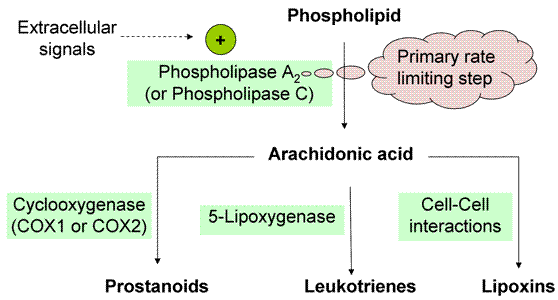|
A knowledge of COX-1 and COX-2 is important for understanding the medical aspects of prostanoid action.
The essential to know differences between COX 1 and COX 2 are:
Distribution:.
- Most cells synthesize COX-1.
- COX-2 is present primarily in:
- cells that mediate pain, fever and inflammation
- endothelial cells that line blood vessels
- the epithelial cells that line the gastrointestinal tract.
Expression:
- COX-1 and COX-2 are encoded by different genes.
- COX-1 is synthesized at a relatively constant rate; its synthesis is not induced.
- COX-2 synthesis is induced by extracellular signals; in cells not receiving these signals, COX-2 is not present or is present in small amounts.
- Glucocorticoids suppress expression of the COX-2 gene.
COX inhibitors:
- NSAIDS (non-steroidal anti-inflamatory drugs) other than aspirin inhibit both COX-1 and COX-2.
- Aspirin inhibits COX-1 and alters the activity of COX-2 (in the presence of aspirin COX-2 produces lipoxin precursors rather than prostaglandin H).
- Inhibition of COX-2 provides relief from pain, fever and inflammation.
- Inhibition of COX-1 increases irritation of the stomach lining and decreases blood clotting.
- Some drugs specifically inhibit COX-2.
|
